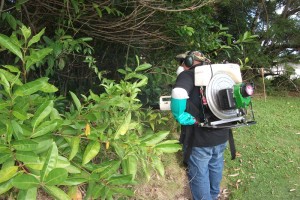One New Dengue Case Added as County Declares Emergency
One additional case of dengue fever was confirmed on the Big Island since Friday. The case brings the total number of individuals infected with the virus to 251 since the initial recorded illness in September.
Of the 251 that have been infected, the Hawai’i Department of Health is currently listing two known cases as “potentially infectious.” Individuals at an infectious stage of their illness can pass the dengue virus to mosquitos who can then potentially infect other humans. Onset of illness for the individuals listed as “potentially infectious” ranges from Jan. 29 through Feb. 1.
Hawai’i County Mayor Billy Kenoi declared a state of emergency on the island Monday morning. The announcement came just under a week after a press conference involving Governor David Ige, Mayor Kenoi, and Darryl Oliveira, Hawai’i County Civil Defense Administrator and Incident Commander.
During Tuesday’s news conference, Governor Ige held his ground regarding response to the outbreak and forwarded any decision to making a declaration to county-level officials.
Governor Ige previously was under fire by Representative Tulsi Gabbard, who on Jan. 29, urged the governor to declare a state of emergency.
“The dengue fever outbreak on the Big Island continues to worsen. We cannot afford to wait any longer for the aggressive action necessary to combat the spread of this serious disease. An emergency proclamation from the Governor is long overdue,” Representative Gabbard said in January.
During the news conference last Tuesday, Administrator Oliveira said that a proclamation was close.
“It’s not because we don’t have control over the situation or any shortage of resources currently,” said Oliveira. “We’d like to stay ahead of the response.”
In total, 227 of the overall cases have impacted Big Island residents, while 24 have involved visitors to the island. The total number also includes 45 children, identified as individuals under the age of 18.
DOH lists 1,124 individuals as excluded from the count. Individuals excluded had negative test results and/or lacked case criteria. Since Friday, 15 cases have been excluded.
Community meetings continue to take place throughout the month of February on a weekly basis in both East and West Hawai’i.
Hilo sessions take place on Thursdays at 11:30 a.m. at the State Office Building, located on Aupuni Street. Kona sessions are held at the same time, but at the West Hawai’i Civic Center, Mayor’s Conference Room.
Tuesday sessions are being held at Yano Hall in Captain Cook, beginning at 12:30 p.m.
The community meetings provide updates and answers to questions from the community about the dengue fever outbreak on the Big Island, as well as education about the prevalence, transmission, and symptoms of dengue fever, along with outbreak response efforts, how to interpret case counts and maps, and the best ways to “Fight the Bite.”
Symptoms of dengue fever include fever, joint or muscle pain, headache or pain behind the eyes, and rash.
Those interested in obtaining general information about the current Big Island dengue fever investigation should call 2-1-1 and talk with Aloha United Way.
Anyone who thinks they may have contracted dengue fever on the Big Island should call 933-0912 if they are located in East Hawai‘i or 322-4877 in West Hawai‘i. If an individual is currently ill and concerned that they may have contracted dengue fever, they should contact their primary care physician.
Civil Defense suggests the following to aid in reducing potential mosquito breeding areas around homes and businesses:
- Remove or eliminate standing water that provides sources for mosquito breeding such as buckets or puddles.
- Fix leaky faucets and outdoor hoses that are dripping water.
- Treat bromeliads and other plants that hold water with a larvacide or chlorine bleach solution.
- Clean gutters to allow water to drain freely.
- Repair screens and windows to help keep mosquitoes out.
- Dispose of old tires at no charge at county transfer stations islandwide.
Mosquito concerns should be reported to 974-6010 in East Hawai‘i or 322-1513 in West Hawai‘i.
















